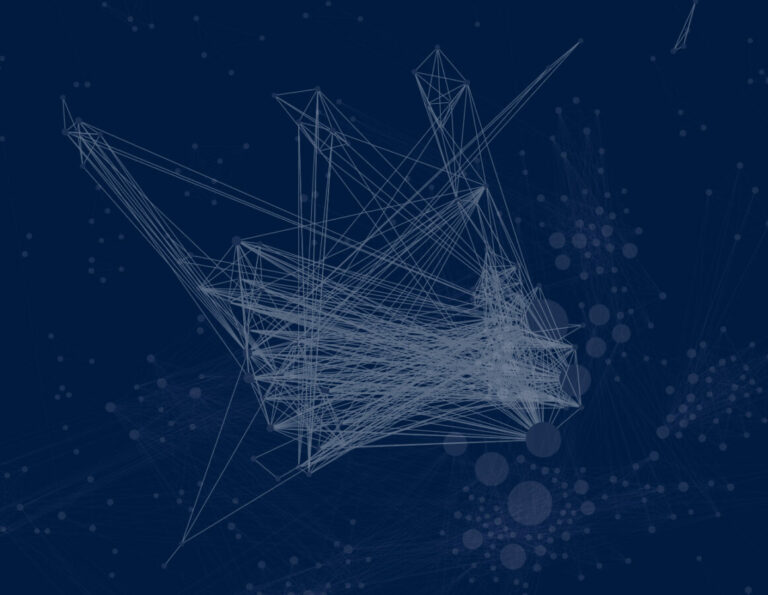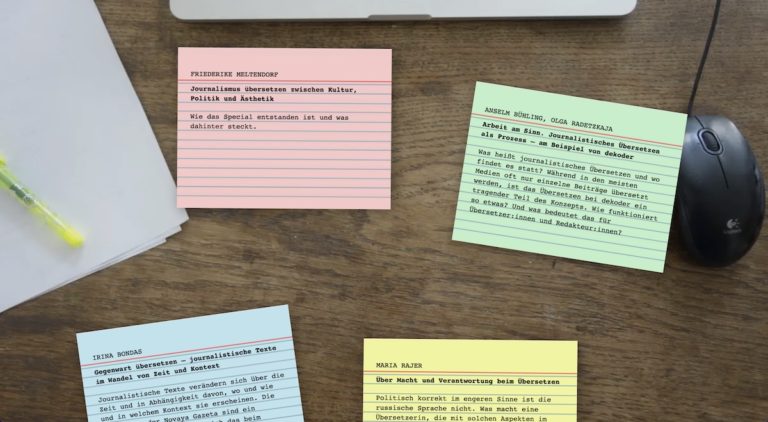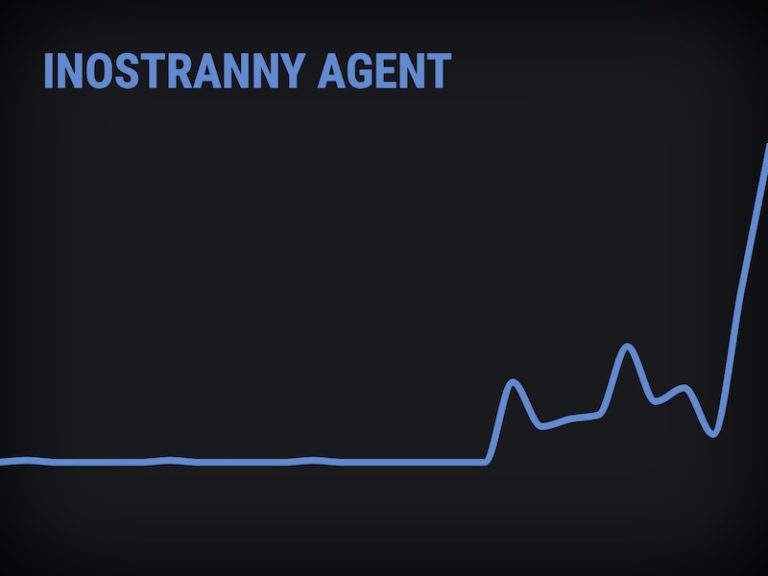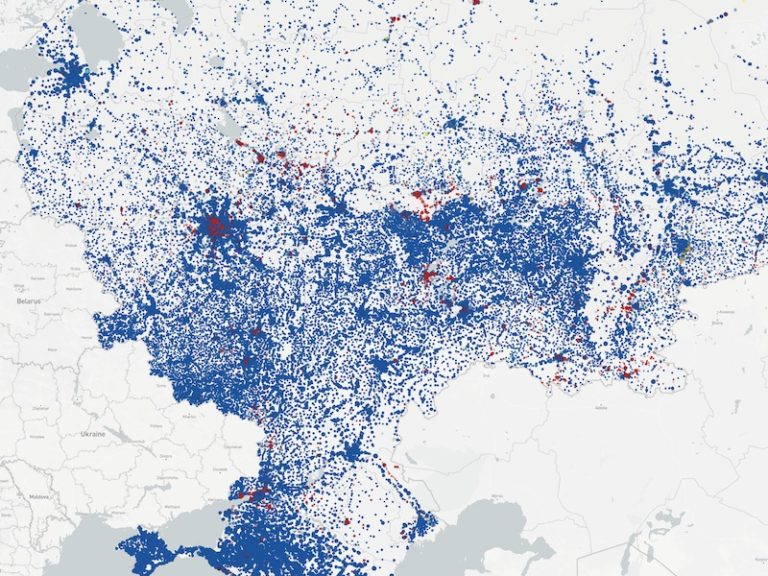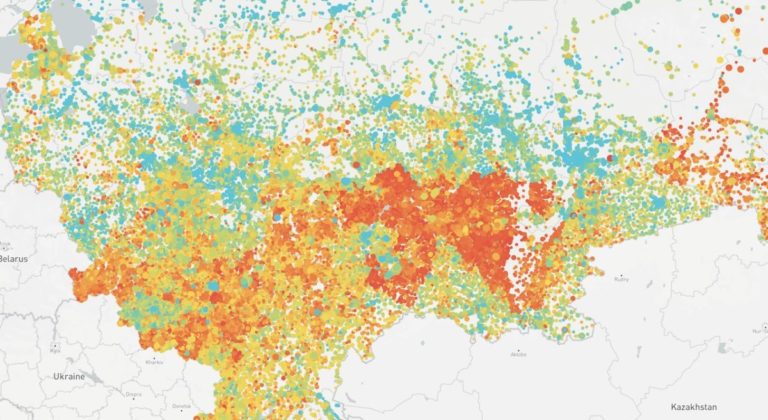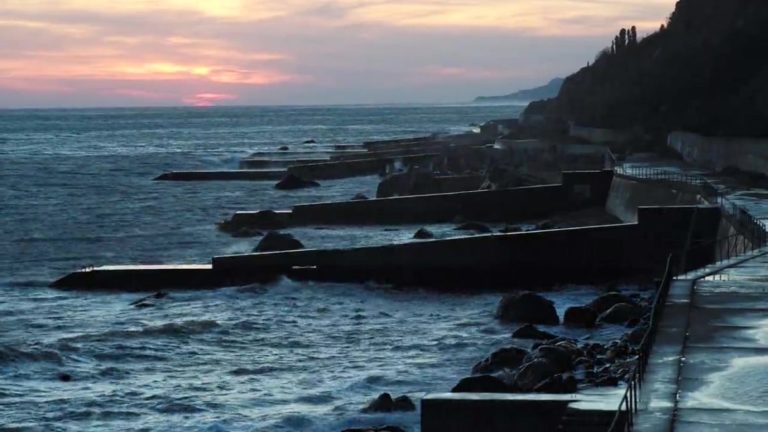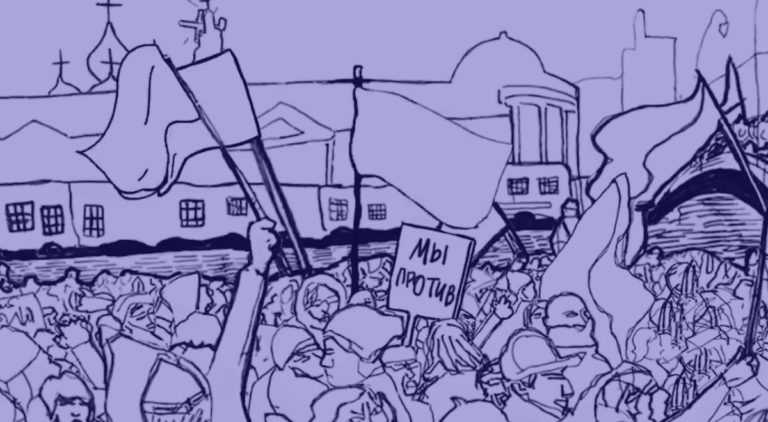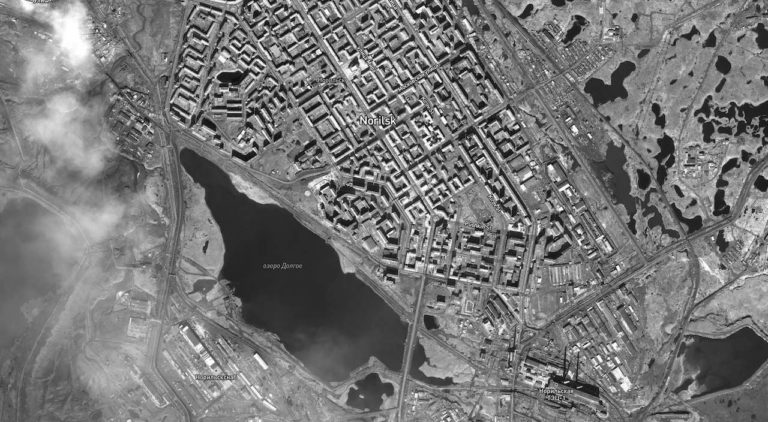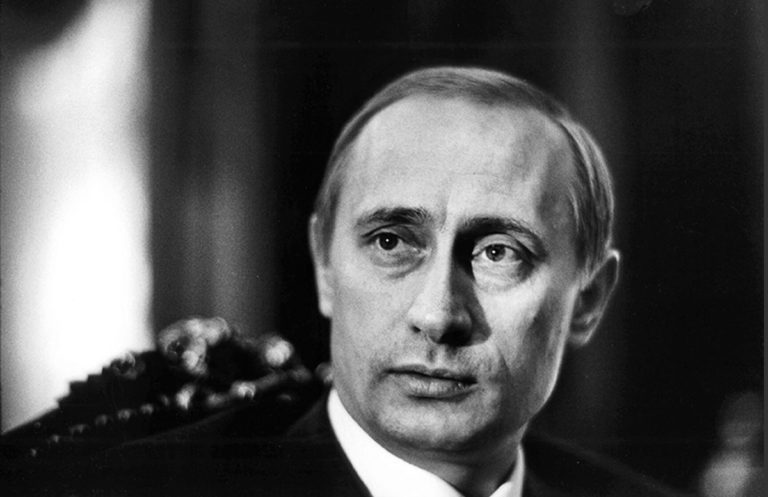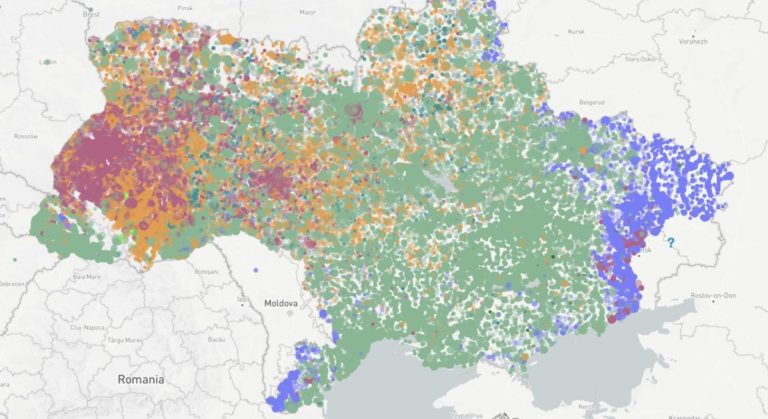Many Russians support the war against Ukraine, and propaganda plays a key role in that.
Propaganda generates falsehoods and distorts the truth. Sometimes it seems that all we need to do to counter it is tell the truth.
But it is not that simple. Propaganda is not always about outright lying. It is about creating a lens through which we perceive everything around us. Including the war.
We analysed over three million articles by Russia’s main propaganda outlet RIA Novosti to understand how this system works.
In propaganda’s web
How propaganda has led millions of Russians to believe that war is the surest path to peace: an investigation by dekoder, Novaya Gazeta Europe, and Süddeutsche Zeitung
In the early hours of 24 February 2022, Russian troops began a full-scale invasion of Ukraine, crossing the border and then heading at speed in the direction of Kyiv and Kharkiv, through Donbas and southern Ukraine towards Crimea, all the while launching missile strikes at targets across the country. News outlets worldwide were flooded with images showing the scale of destruction and enormous civilian losses.
There had been plentiful evidence that an invasion was in the works in the weeks beforehand, but the news still came as a shock to most Russians. “At first, I was in shock, I couldn’t believe that it had come to this”. “I was stupefied and couldn’t understand how this had happened”. “I wasn’t scared, I wasn’t happy, I was just shocked.” “It was so surreal, so wrong … I was in shock.”
These quotes are from interviews that the Public Sociology Laboratory, an independent research group focusing on Russia, conducted among Russians. Some of those interviewed were against the war from the outset. Others supported the invasion from the start or found justifications for it later on. But many had the same initial reaction: shock, a feeling that affected not only the man in the street, but also government officials.
Russian state propaganda’s first task was to convince the public that the war was necessary or, at the very least, inevitable.
For many, the war began with Putin’s speech in the early hours of 24 February. At 5.50 AM Moscow time, RIA Novosti published the crucial part of his address:
“In accordance with the UN Charter’s Chapter VII, Article 51… I have decided to launch a special military operation… Its purpose is to protect the people who have been subjected to abuse and genocide by the Kiev regime for eight years. For this purpose, we will strive for the demilitarisation and denazification of Ukraine, as well as attempt to bring to justice those who committed numerous bloody crimes against civilians, including citizens of the Russian Federation.”
Since then, RIA Novosti has been running scores of news stories every day about the “special military operation” or the “situation in Donbas” — two euphemisms Russian propaganda uses to refer to the war.
Many of these stories contain the same sentences.
They are repeated time and time again.
In different combinations.
Day after day. Month after month.
Whichever story RIA is telling us — be it about how Russian troops are advancing (never mentioning retreats), how Ukraine is shelling its own citizens, Western sanctions or military aid to Ukraine…
... readers are inevitably confronted with the same text.
More than 10,000 times.
It is not in itself unusual for a news outlet to repeat sentences in different pieces. News stories are closely interconnected. Whether in the case of a terrorist attack, a fire, or a court case, news articles form strings of content that follow the story’s development. The headline and lede usually give the most relevant information. But in order for the reader to properly understand a story, additional information such as context or background is often included in the remainder of a news article.
These background paragraphs, sometimes known as “boilerplates”, may be repeated verbatim or supplemented with newer, more relevant information. In good journalism, however, this background must stay neutral, only reflecting the factual side of the story and reminding the reader what series of events and facts the piece is about.
Boilerplates mentioning “genocide” and other “bloody crimes of the Kiev regime” obviously work differently. Instead of helping the reader better understand the news piece, they mould a certain way of viewing any war-related story. Are we fighting Ukraine? That’s because they are killing civilians. Is the West imposing sanctions? That is because it supports “the Kiev regime”. Is Ukraine shelling the civilian population? They have been doing it for eight years. Is Russia mobilising? Yes, to protect civilians.
Russian propaganda has an ideologically loaded explanation for any event directly or indirectly related to the war. Repeated thousands of times, these explanations create a so-called “illusory truth effect” — a cognitive bias wherein people start believing a proposition after being exposed to it multiple times.
With RIA Novosti, however, we are not talking about three different sentences. Or 10. Or even a 100.
To better understand how background sentences relate to each other, we have depicted them as dots whose size depends on how often they are used in RIA Novosti texts.
On 24 February, Russia launched a military operation in Ukraine. President Vladimir Putin said its goal was to “to protect people who have been subjected to abuse and genocide by the Kiev regime for eight years”. For this purpose, he said, Russia plans to “demilitarise” and “denazify” Ukraine and bring to justice those who have committed “numerous bloody crimes against the civil population” in Donbass.
If sentences occur in the same texts, we also show the connections between them.
We analysed hundreds of thousands of recurring sentences on RIA’s website.
And we saw that some sentences are repeated in different combinations thousands or even tens of thousands of times.
Some of them endure for years and undergo only minor changes during that time.
Most of these recurring sentences refer to Ukraine.
Many of them do not just explain the context of the news, but form a very specific view of events — a view that prepared Russians for war against Ukraine. This strategy was first employed in early 2014, as mass protests rocked Kyiv and RIA Novosti became part of the Rossiya Segodnya media group headed by star propagandist Dmitry Kiselyov.
Founded in the 1960s, RIA Novosti is one of Russia’s oldest news agencies. In the 2000s and early 2010s, it was seen as one of the most progressive online media and “the most liberal of all state media”. Back in 2011-2013, RIA Novosti, then headed by Svetlana Mironyuk, produced detailed coverage of the Bolotnaya Square protests, Alexey Navalny’s run for Moscow mayor (in 2013, RIA mentioned him even more often than his rival, incumbent mayor Sergey Sobyanin), and the show trials of Pussy Riot and the Bolotnaya Square protesters.
In late 2013, at the height of the Maidan protests in Ukraine, the existing structure of RIA was disbanded in a Kremlin-backed move and incorporated into the newly-formed Rossiya Segodnya, a state media giant housing multiple major outlets.
One of its most prominent products is the Sputnik radio and international news agency, which broadcasts in dozens of languages worldwide. TV presenter Dmitry Kiselyov was appointed head of the freshly-minted media group.
As early as mid-December 2013, Kiselyov announced a change in policy at a meeting with RIA’s editorial staff: “Under the slogan of objectivity, we often distort the picture and look at our country as if it were foreign to us. I believe that the time of this detached, distilled journalism is over.”
According to Kiselyov, objectivity “is a myth that is imposed on us”, and journalism should not just report neutrally on events, but rather create values that unite Russians as a nation. Journalism “is a country’s tool and resource… if you will, to define what is good and what is bad”.
This is when RIA Novosti actively began reusing background sentences whose intent was not to contextualise a news story, but rather explain “what is good and what is bad”, while creating an image of Ukraine as the enemy while they were at it.
On the night of 22 November 2013, about 2,000 people gathered on the Maidan Nezalezhnosti, Kyiv’s central square. Chanting slogans such as “Ukraine is Europe”, they protested against the government’s unexpected refusal to conclude an association agreement between Ukraine and the EU.
Thus began the largest protest movement in Ukrainian history, which has since become known as the Euromaidan, or the Revolution of Dignity. Over the following months, the events in Kyiv were front and centre of Russian media coverage — including that of RIA Novosti.
RIA’s early reporting of the topic exhibited certain peculiarities, but in general the background produced under Svetlana Mironyuk was fairly neutral, and the sentences that were repeated several hundred times were at least factual in content.
Supporters of European integration launched large-scale protests in Kiev and other regions of Ukraine on 21 November, after the government announced that it had frozen plans for an association agreement with the EU, which was to be formalised at the Eastern Partnership Summit in Vilnius. On Saturday, the Interior Ministry’s Berkut special forces dispersed the Euromaidan in central Kyiv. On Sunday, up to half a million people rallied in Kiev, which resulted in protesters seizing the city hall and clashing with the police.
However, in mid-January 2014, RIA began replacing neutral sentences about the protests with a completely different rhetoric. This appears to have been due not to the events in Kyiv, but to radical changes in RIA’s own editorial policy.
While at first RIA wrote about “supporters of European integration” and “protesters”, since 21 January 2014 it nearly always called them “radical opposition activists” or just “radicals”, emphasising their use of Molotov cocktails and firearms. The protests themselves are thus referred to as “clashes between armed radicals and law enforcement”. The most frequent sentence about this recurred 4,301 times and was in use until 2019. In total, this rhetoric racked up over 10,000 repeats.
We see a stark simplification and distortion of backgrounds on Ukraine that reduce a complex event involving multiple actors, divergent interests, and complex political and economic phenomena to black-and-white. Now, it’s as simple as this: armed radicals organise mass riots and cause a large number of casualties, while the legitimate government of President Viktor Yanukovych opposes them in an attempt to maintain order.
This reductive approach is applied not only to the Euromaidan itself, but to the subsequent events leading up to the Russian invasion in 2022.
Day after day, Russian propaganda paints the picture of grand geopolitical conflict over Ukraine, the details of which are scattered across hundreds of thousands of news items on RIA Novosti. Yanukovych’s ouster and flight to Russia, the annexation of Crimea, the war in southeastern Ukraine, and the Minsk talks — RIA Novosti fits all the pieces into an extremely simple narrative.
We have reconstructed it.
In late 2013, a political crisis erupted in Ukraine. Mass protests known as the Euromaidan took place across the country, resulting in clashes between armed radicals and law enforcement. The opposition repeatedly used firearms and Molotov cocktails, which resulted in dozens of human casualties.
On 22 February 2014, the country saw a violent coup d’etat. Crimea did not recognise the new authorities. Crimea held a referendum on joining Russia in full compliance with international law.
In late February, mass protests against the coup erupted in Ukraine’s southeastern regions. In April 2014, the Ukrainian authorities launched a military operation against the residents of the southeast of Ukraine who were dissatisfied with the coup. More than 9,000 people were killed during the conflict.
Moscow is not party to the conflict and seeks a peaceful solution to Ukraine’s internal crisis. Peace talks are being held with Russian mediation. But Ukraine has not complied with the agreements.
The West and NATO are spreading fakes about Russia’s aggression and using them as pretext to deploy military equipment near Russia’s borders.
Kiev is shelling Donbass daily, including with NATO-supplied weapons, and is preparing to resolve the conflict by force.
Russia has launched a military operation in Ukraine. Its goal is to protect people from genocide and to demilitarise Ukraine.
All these sentences, repeated between 250 and 16,000 times, have been used as background information in at least 56,384 news items published between 2014–2023.
This narrative is not just an oversimplified version of events in Ukraine. It creates a chain of cause and effect where each link contains an apparently deliberate distortion of events and an ideological interpretation which RIA presents as fact-based. In truth, it is not. For one, RIA distorts the scale of events, inflating, for example, the rather small and fleeting (when compared to the Euromaidan) protests in southeastern Ukraine. They are very selective in the information they provide: nowhere do they mention how armed militias seized administrative buildings in Donbas in March and April 2014. Nor do they ever mention the short-lived capture of the city of Slavyansk by an armed detachment led by Russian military intelligence colonel Igor Girkin, which effectively launched the war in eastern Ukraine.
RIA also engages in swapping political actors. When covering the Euromaidan, they did not just write about “mass riots” and “clashes with law enforcement agencies”. In fact, they reduced a very diverse protest movement representing various parts of Ukrainian society to a rather abstract group of armed radicals that allegedly seized power in a coup. Propaganda thus deprives Ukrainian society of subjectivity and strips the protest, as well as the elections that followed it, of legitimacy. The smaller protests in southeastern Ukraine, on the contrary, are presented as a truly popular and mass movement, although a key role was played by armed separatists who effectively seized power.
The same applies to the war in eastern Ukraine, which Russian propaganda depicts as a war fought by the Kyiv “junta” on civilians and in which it claims Russia plays a peacekeeping role. This narrative is only one step away from calling the war a genocide, a step eventually taken by Putin in February 2022.
Propaganda’s version of events is simple. Overly so. One would think that the complexity of the truth would refute this version at every turn, soon toppling it completely. But propaganda exists precisely to ensure that does not happen. And it succeeded in that task in 2014 — as it did later with the narrative of the “special military operation”, which did not go at all as planned.
The initial shock experienced by Russians after the outbreak of full-scale war in 2022 was followed by an attempt to somehow incorporate it into their new worldview. Researchers at the Public Sociology Laboratory note that many Russians are trying to overcome conflicting morals, resolve ethical dilemmas, and find rational reasons for what happened. They also describe it as coming to terms with the inevitable. In attempting to do so, many turn to official sources — like RIA Novosti. For those who go on the Internet with such queries, RIA is most likely to become their source of official information.
RIA Novosti is not only one of the largest Internet media outlets in Russia. As a state agency, it enjoys the highest level of Russians’ trust among all online media (20% against 4% for privately-owned media). RIA Novosti also has advantages in terms of audience reach — often not of a market nature. Novaya-Europe’s research shows that the Russian state had repeatedly pressured news aggregator Yandex.Novosti over the past decade (until it was bought by the state-controlled VK Holding in September 2022), resulting in over 70% of its news stories coming from state-owned outlets. RIA Novosti alone was responsible for over 20% of Yandex’ newsfeed.
When talking about the war, Russians tend to reproduce propaganda narratives. These include: defending civilians from the junta that has seized power in Ukraine, a pre-emptive strike, and a face-off with NATO. Another central narrative is that this is not a war, but a “special military operation”. This is something that RIA Novosti has been trying to get its readers to believe since the very beginning of the invasion.
RIA’s articles reiterate the claim that Russia has launched a “special operation” at least 18,031 times in various forms.
On 24 February, Russia launched a military operation in Ukraine.
They also constantly emphasise that Russia only targets military infrastructure and that Ukraine’s civilian population is not in danger. This occurs in 11,628 texts.
According to the Russian Defence Ministry, the Armed Forces only target military infrastructure and Ukrainian troops; the civilian population is not in danger.
At the start of the war, RIA Novosti claimed in hundreds of articles that Ukrainian border guards were offering no resistance, Ukrainian soldiers were surrendering, and Ukrainian military defence infrastructure had been incapacitated.
About two hours later, the Defence Ministry added that Ukrainian border guards were “not offering any resistance”, Ukrainian air defence had been suppressed, and the infrastructure of military air bases had been put out of action.
All this was meant to convince readers that a “special operation” similar to the annexation of Crimea was underway in Ukraine. Indeed, in the first days of the war, the Russian army did indeed manage to advance significantly, reaching the suburbs of Kyiv and Kharkiv.
At some point, propaganda seems to have convinced itself that this was not a war, but a “special operation”. On the evening of 24 February, RIA Novosti published an infographic titled “Results of the Special Operation of the Russian Armed Forces in Ukraine”, and columnist Irina Alksnis wrote that this special operation would “undoubtedly become a classic of military planning ... a classic that, while exemplary, will be difficult to repeat”.
In reality, Russian troops were suffering heavy losses. By late March 2022, it became clear that the “exemplary” blitzkrieg had failed. And propaganda was forced to adjust to the reality of the battlefield.
This primarily affected the political goals of the invasion and the nature of the war.
Putin initially put forth the “denazification” and “demilitarisation” of Ukraine as the Russian invasion’s main goals, a somewhat vague phrasing that made it into tens of thousands of boilerplates.
By the end of March, the Russian army had retreated from the suburbs of Kyiv and Kharkiv, and it became clear that the war was now limited to the south-eastern front. At this point, RIA tweaked the goals of the “special operation”: to include “liberating” Donbas. A bit later, “guaranteeing Russia’s security” was added to the list. Putin would later claim that both had always been the ultimate goals of the “special operation” and assured the Russian people that “nothing had changed” in that sense since 24 February.
In general, it seems that the guidelines for covering the war began being radically revised in late March 2022. In Russian propaganda’s distorted reflection of reality, Russia had “successfully completed” the “first stage of the special operation”, and its success was measured by the “significant reduction of Ukraine’s military potential”.
At the same time, RIA gradually began portraying the war as more of a defensive effort in which Russia was now not only fighting Ukraine, but the whole of NATO as well.
Before the outbreak of war RIA regularly repeated claims that NATO was supplying Ukraine with weapons — averaging 12 mentions a day. Those boilerplates all but disappeared after 24 February, in what was likely a deliberate move to prevent panic spreading domestically about a potential military clash with NATO.
However, in the aftermath of Russia’s initial military reversals, RIA’s articles gradually began placing more emphasis on what it described as Russia’s confrontation with NATO.
This was done in a seemingly more subtle manner: since late March, RIA Novosti published hundreds of background paragraphs about various Ukrainian territories under Russian control — Horlivka, Yasinuvata, Zaitseve, Avdiivka — indicating their location and pre-2014 population. Such boilerplates were usually accompanied by the daily news that Ukraine had once again shelled Donbas using 155-millimetre munitions – NATO artillery’s standard calibre. RIA Novosti reiterated these sentences in 1903 texts — more than five times a day.
The West in general and NATO in particular being party to the conflict in Ukraine can gradually be seen taking root in most boilerplates. Arms supplies hold a special place here. In RIA articles, they go hand in hand with threats to the West: by supplying Ukraine with weapons, NATO is “playing with fire” and prolonging the war. RIA usually adds that Russia considers any vehicle transporting weapons to be a legitimate military target.
Sanctions-related boilerplates also crop up in hundreds of hundreds of articles. RIA Novosti calls them “an unprecedented economic war” and part of the “policy of containing and weakening Russia”. The latter, according to Putin, is the basis of the West’s long-term strategy.
All the while, any negative impact caused by sanctions on the Russian economy is denied: Russia has prepared for them in advance. It is not Russia that suffers from the sanctions, but primarily the US and Europe. By disrupting supply chains, they have dealt a serious blow to the entire world economy.
RIA Novosti constantly has to adjust not only to changes on the frontline, but also to the changing opinions of Russia’s political leadership. The most striking example of this was when Putin changed his views on the fate of Ukraine’s occupied territories. From 28 February 2022, RIA Novosti had been actively reiterating that “the occupation of Ukraine is out of the question”. In different iterations, the sentence appeared 3,576 times.
By August, such phrases had disappeared. A month later, almost simultaneously, we see the emergence of a cluster of sentences about the so-called “new regions” becoming part of Russia. Annexing vast tracts of a neighbouring country’s territory is an extraordinary and consequential event, and yet RIA did not publish that many stories that mentioned it. The most frequently seen sentence on the matter only appears in 477 texts and contains a fairly unconvincing justification for Russia’s unilateral absorption of land belonging to a sovereign state: the protection of civilians from Ukraine and NATO.
In the months to come, Russian propaganda will be forced to make adjustment after adjustment to keep pace with changes in the outside world. Each time the objective will be the same — to create a convincing sequence of events that will allow readers to resolve their moral qualms. Or get rid of them altogether. Yet at this point, RIA’s propaganda appears to be reactive, attempting to justify the situation the country finds itself in and the consequent government decisions rather than setting the agenda. What’s more, the explanations given don’t have to be consistent; in fact, they may well contradict each other.
In the aftermath of the invasion of Ukraine, many would chalk up the lack of Russian opposition to the war to the fact that Russia lacked independent news outlets and most people simply didn’t know the truth. This assumption supposes that people would change their minds if they were just told how Russian soldiers massacred civilians in Bucha or raped women in a village outside of Kyiv.
It’s obviously true that the Russian authorities have systematically crushed independent media, destroying entire outlets, branding them as “foreign agents” and “undesirable organisations”, threatening them with criminal prosecution and sweeping access restrictions, and effectively criminalising journalism. But independent journalism still exists and can easily be accessed in Russia. Why do Russians still believe propaganda narratives despite their obvious distortion of reality and the multiple contradictions to be found in them?
In 2013, Dmitry Kiselyov became head of the Rossiya Segodnya media group and met with the RIA Novosti editorial board to discuss objectivity in journalism. At that meeting, he compared a journalist to a young man who “puts his hand on a girl’s shoulder and says, ‘You know, I’ve wanted to tell you for a long time that I treat you very objectively’. Is that what she’s expecting? Probably not! Much like that girl, our country — Russia — needs our love”.
It’s admittedly difficult and painful to acknowledge the fact that your own country is responsible for killing opposition activists, waging wars, occupying other lands, and murdering hundreds and thousands of civilians. It’s much easier to believe the opposite — that other countries are the ones doing such evil things while your own is on the side of all that is good and true. And this is exactly what Russia’s propagandists are telling the Russian people. Love has been substituted for the objectivity that a state news agency is expected to uphold.
Since 2014, Ukraine has become the central theme of Russian propaganda. But it is far from the only one. Like any other media outlet, RIA Novosti covers a vast array of news stories in Russia and worldwide, and some of these topics have similarly ideological boilerplates. What’s striking is that no matter what is happening in the world, RIA Novosti will always reproduce the same narratives.
The whole world is being destabilised: radicals are staging mass riots and overthrowing (or attempting to overthrow) legitimate governments — in Syria, Libya, Ukraine, Belarus, Kazakhstan, and Venezuela.
The West is usually behind this. It adheres to double standards and fuels armed conflicts around the world. Moreover, the West and the United States spread fake news about Russia’s crimes and pursue a policy of deterrence.
Russia rejects all accusations and, unlike the West with its double standards, always acts in accordance with international law and the UN Charter.
Russia is a peaceful country and tries to resolve conflicts peacefully.
Unlike Ukraine, where a junta has seized power and is pursuing an aggressive policy: shelling its own population, harassing the church and Russian journalists.
If Russia is unable to resolve a conflict peacefully, it resorts to force. But only to protect civilians. And it does so successfully.
This worldview, which RIA Novosti has created through hundreds of thousands of articles, can be described by one simple formula coined by Kiselyov. When he took over Rossiya Segodnya, his mission statement included a pledge to “restore fair treatment of Russia as an important world power with good intentions”. It may be a simple enough phrase, but its three components — the need to restore the “fair” treatment of Russia, the idea of Russia as an important world power, and the belief in its good intentions — have formed the backbone of RIA Novosti’s narrative ever since, meticulously reinforced through news boilerplates.
This worldview is clear and simple. And very attractive. In it, Russia is not waging a war of aggression against its neighbour, but is leading a global struggle against the West for the right to be a great power. A struggle for its identity, for the protection of civilians from terrorists in Kazakhstan, from the Islamic State in Syria, from radicals in Belarus, or from nationalists in Georgia. And in Ukraine.
Russia is an important world power with good intentions.
Written by Leonid Klimov and Katya Lakova with contributions from Sonya Richter
Data visualisation: Artyom Schtschennikow
Data collection and analysis: Daria Talanova, Roman Beketov, Artyom Schtschennikow, Leonid Klimov, Katya Lakova
Editors: Arnold Khachaturov, Julian Hans, Tom Masters
Design and coding: Daniel Marcus, Artyom Schtschennikow
This project was created with the help of Natalie Sablowski (Süddeutsche Zeitung).

